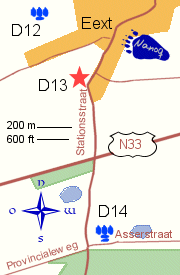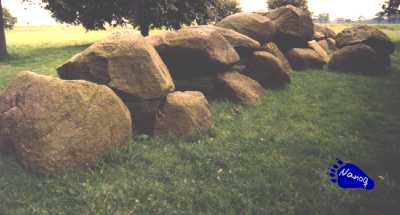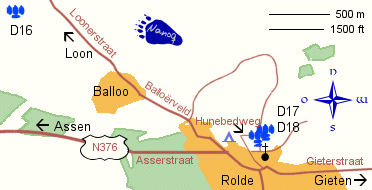
 |
Drenthe, Aa en Hunze (2) |
Nederlando Niederlande
Netherlands
Eŭropo Europa Europe
Index
D12 estas domaĝe sufiĉe forte damaĝita portaleca tombo kun tri de kvar kapŝtonoj kaj ok flankŝtonoj kun du finŝtonoj. De la flankŝtonoj ankoraŭ tri ĉeestas, de la finŝtonoj unu. La eniro oriĝinale konsistis de unu paro de flankŝtonoj kun kapŝtono. Sed ĝi plene estas malaperigita. La tomboĉambro longas 6,8 m kaj larĝas 2,8 m kaj estas orientigita al 24°30′ N.
La tombo troviĝas sudoriente de la vilaĝo Eext kaj ne estas trovebla tre facile. Laŭdire ekzistas montrilo en la nordo de la vilaĝo.
D12
ist ein leider recht stark beschädigtes Portalgrab mit drei von vier Deck-
und acht Tragsteinen, sowie zwei Schlußsteinen. Von den Tragsteinen sind
noch drei vorhanden, von den Schlußsteinen noch einer. Der Eingang hatte aus einem Paar Tragsteinen mit Deckstein bestanden,
der jedoch ganz verschwunden ist. Das Grab ist 6,8 m lang und 2,8 m breit. Die
Kammer wurde nach 24°30′ N ausgerichtet.
noch einer. Der Eingang hatte aus einem Paar Tragsteinen mit Deckstein bestanden,
der jedoch ganz verschwunden ist. Das Grab ist 6,8 m lang und 2,8 m breit. Die
Kammer wurde nach 24°30′ N ausgerichtet.
Das Grab befindet sich südwestlich des Dorfes Eext und ist nicht ganz leicht zu finden. Im Norden des Dorfes gibt es einen Wegweiser.
D 12 is a quite severely damaged portal grave with three of four capstones, eight sidestones and two endstones. Of the sidestones three are still present, while one of the endstones is missing. The entrance once consisted of a pair of sidestones with a capstone which has disappeared completely. The grave is 6.8 m long and 2.8 m wide (22.3 ft : 9.2 ft). The chamber is oriented to 24°30′ North.
The grave lies southwest of Eext and is not so easily found. There are signposts in the north of the village.
D13 estas unikaĵo de la megalita kulturo, ĉar ĝi estas la ununura ekzemplero tiutipa en Nederlando. Temas pri ŝtupara tombo, t.s. la subtera ĉambro estas atingebla tra kvar ŝtupoj. Ĝi konsistas de ses flankŝtonoj kaj du finŝtonoj. Ĝi longas 4,3 m, larĝas 3,2 m kaj estas orintigita al 115°30′ O. Unu de la mankintaj kapŝtonoj estis retrovata kaj remetata 1976. (Ĝi estis misuzita kiel ponteto.) Laŭdire troviĝas dua kapŝtono en la muraro de la preĝejo, kiu ofte jam okazis kun multnombraj ŝtontomboj en Eŭropo.
Tiu tombo estis trovata en 1735 kaj tombrabistoj ĝin malplenŝtelis dum la sekvintaj jaroj. En 1756 unuafoje ĝin esploris kaj renovigis J. Van Lier. Tiam multnombraj trovitoj elteriĝis; Van Lier eĉ raportis pri urnoj kun bruligitaj ostoj, kio tamen estas dubinda. Siamane skribita estas la unua libro (1760) pri la megalitaj tomboj en Nederlando. La tombon novafoje esploris 1927 S-ro Van Giffen. Li trovis la ŝtuparon kiun Van Lier siatempe desegnis en sia libro.
La tombo troviĝas en la suda parto de Eext. Sekvu la ĉefan straton (Statioonsstraat) veninta de Annen resp. Anloo direkte arbaren. Ĉe la fino de la loĝarejo vi trovas vojon dekstren kiu sekvas al la monteto en kiu kaŝiĝas la tombo. La tombo mem ne estas videbla elstrate.
D13 ist eine Besonderheit der Megalithkultur, da es das einzige Exemplar seiner Art in den Niederlanden ist. Es handelt sich um ein sogenanntes Treppengrab, dessen Kammer durch eine Treppe von vier Stufen zu erreichen war. Sie besteht aus sechs Tragsteinen und zwei Schlußsteinen. Sie ist 4,3 m lang, 3,2 m breit und nach 115°30′ O ausgerichtet. Einer der fehlenden Decksteine wurde 1976 wiedergefunden und an seinen ursprünglichen Platz zurückgebracht. (Er war bis dahin als Brücke mißbraucht worden.) Angeblich soll ein zweiter Deckstein sich im Gemäuer der eexter Kirche befinden, was mit Megalithgräbern in Europa des öfteren schon geschah..
Dieses Grab wurde 1735 entdeckt und im laufe der folgenden Jahre von Grabräubern leergeplündert. 1756 wurde es erstmals untersucht und von J. Van Lier renoviert. Dabei wurden zahlreiche Funde zutage gebracht; Van Lier berichtete von Urnen mit verbrannten Knochen, was jedoch angezweifelt werden muß. Von ihm stammt auch das erste Buch (1760) über die Megalithgräber in den Niederlanden. 1927 wurde das Grab von Van Giffen erneut untersucht. Dieser fand die Treppe, die Van Lier seinerzeit gezeichnet hatte.
Das Grab befindet sich im südlichen Teil von Eext. Wir folgen der Hauptstraße (Stationsstraat) von Annen, bzw. Anloo in Richtung Wald. Gegen Ende des Wohngebietes finden wir einen Weg nach rechts, der zum Hügel führt, in dem das Grab verborgen liegt. Das Grab ist von der Straße aus nur als Grashügel sichtbar.
D13, the "grave-cellar" of Eext, is something unique in the megalithic cultures, the only specimen of its type in the Netherlands. It's a so-called stair-grave, whose chamber has been reached via a small stairway. It consists of six sidestones and two endstones. It is 4.7 meters (15 ft) long, 3.2 meters (10.5 ft) wide and is oriented to 114°30′ East. One of the missing capstones was re-found in 1976 and brought back to its original position. (Until then it was misused as a bridge.)
There are rumours that a second capstone should be in the walls of the church of Eext, something which often happened to megalithic tombs in Europe.
This tomb was discovered in 1735 and plundered over the course of the years. In 1756 it was first examined and restored by J. van Lier. Many digs have been carried out; Van Lier reported urns with charred bones, but this is rather doubtful. He also wrote the first book about the megalithic tombs in the Netherlands (1760).
In 1927 the grave was examined once again by Van Giffen. He found the stairway, which Van Lier had sketched earlier.
The grave lies in the southern part of Eext. Follow the mainstreet (Stationsstraat) from Annen or Anloo heading for the forest. At the end of the residential area there a small street leads to the right, going to the hill in which the grave is hidden. The grave itself cannot be seen from the street.
Ne nur tre bela kaj granda sed samtempe ankaŭ bone konservata koridora
tombo kiu oriĝinale konsistis de naŭ kapŝtonoj sur 18 flankŝtonoj kun du finŝtonoj. Tri kapŝtonoj mankas, resp. kuŝas kiel ŝtoneregoj
en la ĉambro. La eniro konistis de du paroj da flankŝtonoj kun du
kapŝtonoj, de kiu du flankŝtonoj ankoraŭ estas videblaj. La ĉambreto
longas 18 m kaj larĝas 4,5 m kaj estas orintata al 83°30′. Ankoraŭ
ĉeestas ok ŝtonegoj kiuj unue estis parto de ŝtoncirklo.
kun du finŝtonoj. Tri kapŝtonoj mankas, resp. kuŝas kiel ŝtoneregoj
en la ĉambro. La eniro konistis de du paroj da flankŝtonoj kun du
kapŝtonoj, de kiu du flankŝtonoj ankoraŭ estas videblaj. La ĉambreto
longas 18 m kaj larĝas 4,5 m kaj estas orintata al 83°30′. Ankoraŭ
ĉeestas ok ŝtonegoj kiuj unue estis parto de ŝtoncirklo.
La tombo estas bone atingebla el Eext kaj same el Gieten; eĉ troviĝas aŭtoparkejo flanke. El Eext sekvu la straton Statioonsstraat, kiu ankaŭ gvidas al D13 kaj krucas la aŭtostraton N33 ĝis la arbarobordo. Ĉe tiu stratkruco ni trovas la tombon.
De Gieten ni krucas la aŭtostrato N33 kaj sekvas la vojon laŭlonge de la arbaro direkte al Rolde, ĝis vi trovas la tombon ĉe vojkruco.
Nicht nur ein sehr schönes und großes sondern zugleich ein gut erhaltenes Ganggrab, das aus ursprünglich neun Decksteinen auf 18 Tragsteinen mit zwei Schlußsteinen bestand. Drei Decksteine fehlen, bzw. liegen als Bruchstücke in der Kammer. Der Eingang bestand aus zwei Paar Tragsteinen mit zwei Decksteinen, wovon noch drei Tragsteine zu sehen sind. Die Grabkammer ist 18 m lang und 4,5 m breit und nach 83°30′ ausgerichtet, ferner sind noch acht Steine zu sehen, die einst Teil eines Steinkreises waren.
Das Grab ist gut sowohl von Eext als auch von Gieten zu erreichen,
es befindet sich sogar ein Parkplatz daneben. Von Eext folgt man
der Stationsstraat an D13 vorbei und kreuzt die Autobahn N33 bis an den
Waldrand. An dieser Kreuzung finden wir das Grab.
Von Gieten aus überqueren wir die N33 und folgen dem Fahrweg
am Waldrand entlang in Richtung Rolde, bis wir an der Kreuzung das Grab
finden.
Not only a very beautiful but also a very well preserved corridor-tomb, which originally consisted of nine capstones on 18 sidestones with two endstones. Three capstones are missing or lie as broken pieces in the chamber. The entrance originally consisted of two pairs of sidestones with two capstones, while three sidestones are still present. The chamber is 18 m long and 4.5 m wide (59 ft : 15 ft) and is oriented to 83°30′. Furthermore eight stones are still visible, which once were part of the stone-ring.
The grave can be easily reached from Eext as well as from Gieten and there is even a parking area nearby. From Eext follow the street Statioonsstraat along tomb D13 and cross the motorway N 33 until the edge of the forest. The grave can be found at the crossroads.
From Gieten cross N 33 and follow the way alongside the forest in the direction of Rolde until you find the grave at the crossroads.
Tio estas relative granda portaleca tombo konsistanta de 19 flankŝtonoj kaj naŭ kapŝtonoj kiuj nur 1978 estis remetataj al siaj oriĝinalaj lokoj. Same ambaŭ finŝtonoj kaj du flankŝtonoj de la eniro ĉeestas. Sur la sesa ŝtono troviĝas truetoj kiuj eble estis ujoj por likvaj oferaĵoj kiel lakto, mielo, graso ktp. Tio estas unikaĵo kiu ankoraŭ ne duafoje estas trovita en Nederlando. La tombo longas 15,6 m, larĝas 3,9 m kaj estas orientata al 96°30′
Ĝi estas atingebla tra sablovoje kaj el Loon kaj el Balloo.
El Loon ni sekvu la straton al Balloo kaj krucas rivereton (Taarlose Diep) Poste ni turnas dekstren direkte Kampsheide. Post kelkaj cent metroj ni trovas la tombon maldekstraflanke.
De Balloo la vojo al Loon disforkiĝas. Ni sekvu la vojon maldekstren al Kampsheide (Ne al Loon). Ĉe la bordo de la arbareto kaj erikejo ni sekvas ĉe vojkruciĝo dekstren ĝis ni trovas baldaŭ la tombon dekstraflanke.
Dies ist ein relativ großes Portalgrab mit 19 Tragsteinen und neun Decksteinen, die erst 1978 wieder an ihren alten Platz zurückgelegt worden sind. Ebenso sind beide Schlußsteine vorhanden, wie auch zwei Portaltragsteine. Auf dem sechsten Stein sind Vertiefungen zu finden, die auf Trankopferlöcher schließen lassen. Eine Eigenschaft, die bei niederländischen Megalithgräber bisher nicht gefunden wurde. Das Grab ist 15,6 m lang, 3,9 m breit und nach 96°30′ ausgerichtet.
Das Grab ist über einen Sandpfad sowohl aus Loon
 als auch von Balloo zu erreichen.
als auch von Balloo zu erreichen.
Von Loon aus folgen wir der Straße nach Balloo und überqueren
einen kleinen Fluß (Taarlose Diep). Danach biegen wir einen kleinen
Weg nach rechts ab in Richtung Kampsheide. Nach einigen hundert Metern
finden wir das Grab auf der linken Seite.
Von Balloo aus gabelt sich der Weg nach Loon am Ortsausgang.
Wir nehmen den Weg nach links zur Kampsheide (nicht nach Loon).
Am Wald- und Heidenrand biegen wir an der Kreuzung rechts ab und folgen dem
Weg. Nach kurzer Zeit finden wir das Grab auf der rechten Seite.
This is a relatively large portal tomb with 19 sidestones and nine capstones which were only in 1978 put back in their original places.
Also both endstones are still present as well as the two portal sidestones. There are cup-marks on the sixth capstone which were probably used for liquid sacrifices. In the Netherlands these cup-marks are unique.
The tomb is 15.6 m (51 ft) long, 3.9 m (13 ft) wide and the chamber is oriented to 96°30′.
It can be reached via a sandy path from Loon and also from Balloo.
From Loon follow the road to Balloo and cross a narrow river (Taarlose Diep). Then turn right into a small lane heading for Kampsheide. After some hundred meters you find the grave on the left side.
From Ballo the road to Loon forks as it leaves the village. Take the left fork to Kampsheide (not to Loon). At the edge of the forest and heath turn right and follow the pathway. After a short time the tomb can be found on the righthand side.
D17 kaj D18 estas du arpate belaj kaj facile atingeblaj portaleca tomboj, kiuj ankaŭ bele estas situataj en la ombro de mezepoka preĝejo de Rolde.
D17
konsistas de 16 flankŝtonoj kun ok kapŝtonoj, de kiu nur unu ankoraŭ
kuŝas sur siaj flankŝtonoj.  Same
ambaŭ finŝtonoj kaj du portalŝtonoj ĉeestas. La ĉambro
estas orientata al 97°30′. Ĝi longas 13,9 m kaj larĝas 3,8
m.
Same
ambaŭ finŝtonoj kaj du portalŝtonoj ĉeestas. La ĉambro
estas orientata al 97°30′. Ĝi longas 13,9 m kaj larĝas 3,8
m.
D18 estas pli bone konservata. Sep kapŝtonoj kuŝas sur 14 flankŝtonoj kaj du finŝtonoj. Krome estas videblaj du portalaj flankŝtonoj kvankam ili preskaŭ estas sinkitaj en la sablon. La ĉambro de la tombo estas 13,6 m longa kaj larĝas 3,5 m kaj estas orientata al 74°30′
Ambaŭ tomboj estas facile atingeblaj. Ili troviĝas ĉe la norda vilaĝlimo de Rolde ĉe la vojoal anderen. Ĉe la preĝejo sekvu vojmontrilojn laŭ la strateto Hunnebedweg.
D17 und D18 sind zwei ausgesprochen schöne und gut zu erreichende Portalgräber, die auch noch sehr schön im Schatten der mittelalterlichen Kirche von Rolde gelegen sind. Daneben lädt ein Picknickplatz zur Pause ein.

D17 besteht aus 16 Tragsteinen mit acht Decksteinen, von denen nur einer noch
auf den Tragsteinen liegt. Ebenso sind noch beide Schlußsteine und zwei
Portalsteine vorhanden. Die Kammer ist nach 97°30′ ausgerichtet. Sie
ist 13,9 m lang und3,8 m breit.
D18 ist besser erhalten. Sieben Decksteine ruhen auf 14 Trag- und zwei Schlußsteinen.
Ferner sind zwei Portaltragsteine noch sichtbar, wenngleich sie fast im Sand
versunken sind. Die Kammer ist 12,6 m lan, 3,5 m breit und nach 74°30′
ausgerichtet.
Die beiden Gräber sind leicht zu erreichen. Sie liegen am nördlichen Ortsrand von Rolde am Weg nach Anderen. An der Kirche im Zentrum folgen wir den Wegweisern am Hunnebedweg.
D17 and D18 are two remarkably beautiful and well-preserved portal-graves, beautifully situated in the shade of the medieval church of Rolde under huge and old oaks.
D17 consists of 16 sidestones with eight capstones, of which only one still lies on its sidestones. Both endstones are still present also two portalstones. The chamber is oriented to 97°30′. It is 13.9 meters (46 ft) long and 3.8 meters (12.5 ft) wide.
D18 is better preserved. Seven capstones lie on 14 sidestones and two endstones. Both portal-sidestones are still visible, even if they are nearly sunk in the sandy ground. The chamber is 12.6 meters (41 ft) long and 3.5 meters (11.5 ft) wide and oriented to 74°30′.
The tombs are easily reached from Rolde. They are lying at the northern border of the village on the way to Anderen. From the church in the centre follow the arrows in the street "Hunebedweg".
lasta ĝisdatigo letzte Überarbeitung last update: 17-3w-02